Adam Blatner
Words and Images from the Mind of Adam Blatner
Maps of Identity
Originally posted on July 25, 2013
These figures illustrate some elements of “social depth psychology.” People aren’t at all individuals in the sense of being absolutely non-divided; there is indeed a potential for more or less coordination, but on the whole, people play many roles and entertain largely different sets of attitudes and aspects of their personalities in each role. So this diagram on the right might be a fairly superficial map of the social-individual nature of a person, juggling a number of relevant roles: Each role “box” is a frames of reference.
So this diagram on the right might be a fairly superficial map of the social-individual nature of a person, juggling a number of relevant roles: Each role “box” is a frames of reference.
When two people meet, there is this dual figure on the left:  It’s more permeable. Notice that the right figure here on the left is unfinished, and in that sense, less clear. This symbolizes the way people are unsure, incomplete, continuously re-structuring their own world. The two figures are at an angle, one is more subservient or at a lower status. This is co-created fairly quickly by nonverbal communications. There are scores of variables that go into this determination, from temperamental and neurosis to societal valuations that are also to some degree internalized—or not: Honors, rank, race, coloring, education, success experiences, amounts of validation by others, secret shames and guilts, entitlements, privilege, collective assumptions of superiority of religion or nation, technological advancement, etc.
It’s more permeable. Notice that the right figure here on the left is unfinished, and in that sense, less clear. This symbolizes the way people are unsure, incomplete, continuously re-structuring their own world. The two figures are at an angle, one is more subservient or at a lower status. This is co-created fairly quickly by nonverbal communications. There are scores of variables that go into this determination, from temperamental and neurosis to societal valuations that are also to some degree internalized—or not: Honors, rank, race, coloring, education, success experiences, amounts of validation by others, secret shames and guilts, entitlements, privilege, collective assumptions of superiority of religion or nation, technological advancement, etc.
These maps are constantly shifting, alive, open to new possibilities, generating new frames, roles. 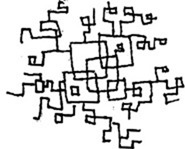 This picture on the right hints at this dynamism.
This picture on the right hints at this dynamism.
Part of this, on the left, is the ways new roles keep getting added, shuffled around, revised. 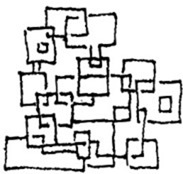 This is the dynamism of psychology, involving getting tired, resting, moving into a mundane role, and from there into an interesting avocation, etc.
This is the dynamism of psychology, involving getting tired, resting, moving into a mundane role, and from there into an interesting avocation, etc.
It may seem similar, but here on the right below is a map that really represents the way four or five people are collaborating on the same task, the same general goal,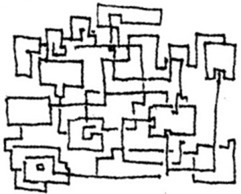 only each has his or her own approach, as symbolized by the boxes in the different corners.
only each has his or her own approach, as symbolized by the boxes in the different corners.
Let this seem overly complex, let me say it clearly: It is indeed, intrinsically quite complex, and there is no way of suggesting that it is not. Certain tasks and perspectives may be simplified for various reasons, and this may be useful for certain purposes. That can be said honestly. But that doesn’t mean that the situation is indeed simple. This distinction is lost on many people.
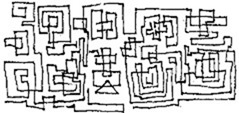 There has been a good deal of discussion of the nature of family dynamics at a theoretical level. This picture adds to that analysis. More than two people can be involved in establishing their various roles and needs. What’s shown here again are the intrinsic “frames of reference” for the various players involved.
There has been a good deal of discussion of the nature of family dynamics at a theoretical level. This picture adds to that analysis. More than two people can be involved in establishing their various roles and needs. What’s shown here again are the intrinsic “frames of reference” for the various players involved.
Finally, on the right is a picture of a larger organization and its many interacting frames of reference or role involvements.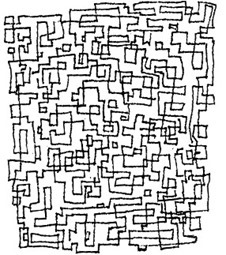 Note that they are not distinct—one leads to or bleeds over into another. Social depth psychology works that way. It recognizes more distinctly that many phenomena are described as systems rather than individuals; the system has reinforcing and dampening dynamisms that go beyond the health or sickness or desire or awareness of any individual.
Note that they are not distinct—one leads to or bleeds over into another. Social depth psychology works that way. It recognizes more distinctly that many phenomena are described as systems rather than individuals; the system has reinforcing and dampening dynamisms that go beyond the health or sickness or desire or awareness of any individual.
In summary, these diagrams are not meant to plot out clean issues, but rather to suggest the dynamic flow of role constructions, dissolutions, re-framings, and negotiations the operate at multiple levels simultaneously in many social contexts. We may simplify the diagrams for certain purposes, but to say again, that doesn’t mean that the relations themselves are simple.
Social depth psychology recognizes more clearly that interpersonal relationships are so multi-faceted and real, drawing not only on the projections and transferences and realistic perceptions of the parties involved, but also mixing these with a host of subtle nonverbal communications and reinforcing or suppressing dynamics that amplify these dynamics. Often there are distortions, mistaken interpretations, superimposed stereotypes, imposed power dynamics, and so forth. Alas, this just makes it harder to pin down human interactional analysis, but that’s the way it goes.
Categories
- Action Explorations
- Art (Mandalas, Doodles, Scripts)
- Autobiographical
- Book Reviews
- Current Events
- Essays and Papers
- Follies
- Foolin Around
- History
- Mind-Spectrums
- My Favorite Things
- Play and Spontaneity
- Psychodrama
- Psychological Literacy
- Psychology
- Psychotherapy and Psychiatry
- Scriptology
- Social-Depth Psychology (Sociometry)
- Spirituality and Philosophy
- Uncategorized
- Whassup?
- Wisdom-ing
- World of Almost-Real
- Zordak's Journal
Archives
- October 2021
- August 2020
- January 2020
- November 2019
- March 2019
- August 2018
- July 2018
- June 2018
- May 2018
- April 2018
- March 2018
- February 2018
- January 2018
- December 2017
- November 2017
- October 2017
- September 2017
- August 2017
- July 2017
- April 2017
- March 2017
- February 2017
- January 2017
- December 2016
- November 2016
- October 2016
- September 2016
- August 2016
- July 2016
- May 2016
- April 2016
- March 2016
- February 2016
- January 2016
- December 2015
- November 2015
- October 2015
- September 2015
- August 2015
- July 2015
- June 2015
- May 2015
- April 2015
- March 2015
- February 2015
- January 2015
- October 2014
- September 2014
- July 2014
- June 2014
- May 2014
- April 2014
- March 2014
- February 2014
- January 2014
- December 2013
- November 2013
- October 2013
- September 2013
- August 2013
- July 2013
- June 2013
- May 2013
- April 2013
- March 2013
- February 2013
- January 2013
- December 2012
- November 2012
- October 2012
- September 2012
- August 2012
- July 2012
- June 2012
- May 2012
- April 2012
- March 2012
- February 2012
- January 2012
- December 2011
- November 2011
- October 2011
- September 2011
- August 2011
- July 2011
- June 2011
- May 2011
- April 2011
- March 2011
- February 2011
- January 2011
- December 2010
- November 2010
- October 2010
- August 2010
- July 2010
- June 2010
- May 2010
- April 2010
- March 2010
- February 2010
- January 2010
- December 2009
- November 2009
- August 2009
- July 2009
- June 2009
- April 2009
- March 2009
- February 2009
- December 2008
- October 2008
- September 2008
- August 2008
- July 2008
- June 2008
- May 2008
- April 2008
- March 2008
- February 2008
- January 2008
- December 2007
- January 2007
- December 2006
- September 2006
- December 2005
- October 2005
- February 2005
- December 2004
- October 2004
- May 2004
- July 2003
- October 2002
- September 2002
- August 2002
- July 2002
- June 2002
- August 2001
- December 1980
- December 1979
Leave a Reply